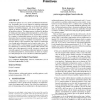Free Online Productivity Tools
i2Speak
i2Symbol
i2OCR
iTex2Img
iWeb2Print
iWeb2Shot
i2Type
iPdf2Split
iPdf2Merge
i2Bopomofo
i2Arabic
i2Style
i2Image
i2PDF
iLatex2Rtf
Sci2ools
OOPSLA
2005
Springer
2005
Springer
Modeling architectural patterns using architectural primitives
Architectural patterns are a key point in architectural documentation. Regrettably, there is poor support for modeling architectural patterns, because the pattern elements are not directly matched by elements in modeling languages, and, at the same time, patterns support an inherent variability that is hard to model using a single modeling solution. This paper proposes tackling this problem by finding and representing architectural primitives, as the participants in the solutions that patterns convey. In particular, we examine a number of architectural patterns to discover those primitive ions that are common among the patterns, and at the same time demonstrate a degree of variability in each pattern. These abstractions belong in the components and connectors architectural ough more abstractions can be found in other views. We have selected UML 2 as the language for representing these primitractions as extensions of the standard UML elements. The added value of this approach is twofo...
| Added | 28 Jun 2010 |
| Updated | 28 Jun 2010 |
| Type | Conference |
| Year | 2005 |
| Where | OOPSLA |
| Authors | Uwe Zdun, Paris Avgeriou |
Comments (0)

